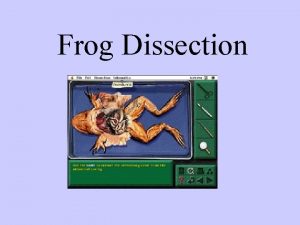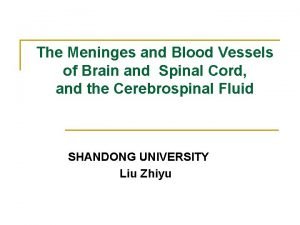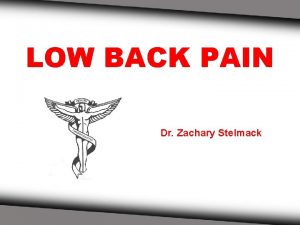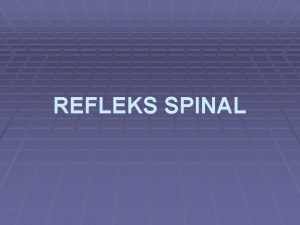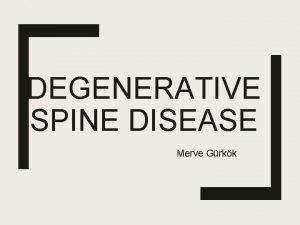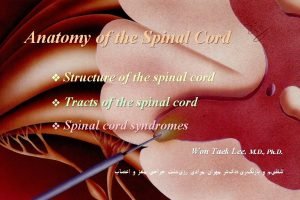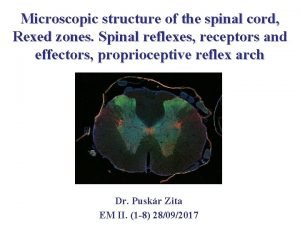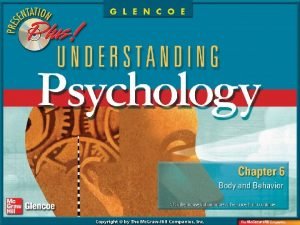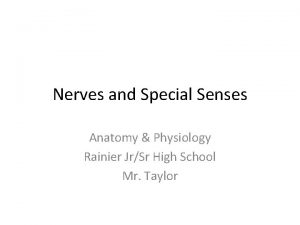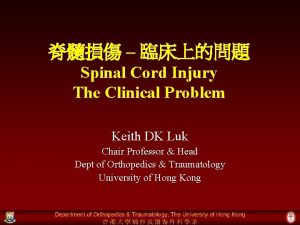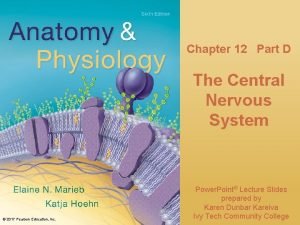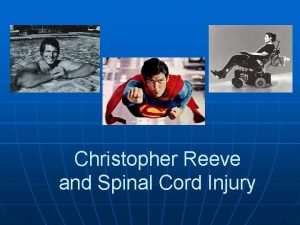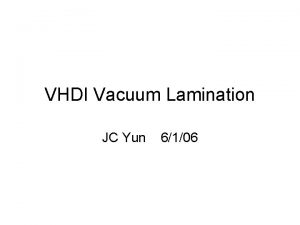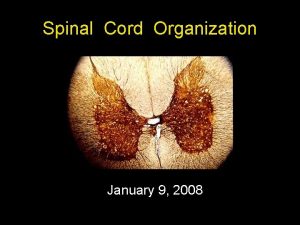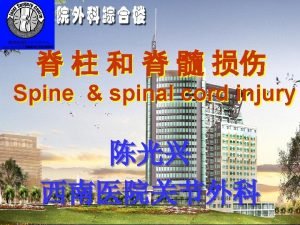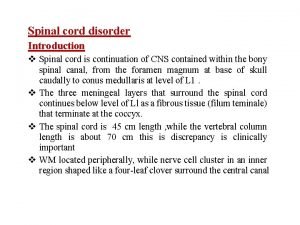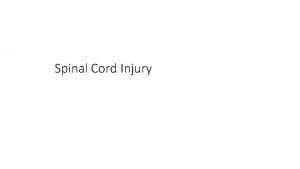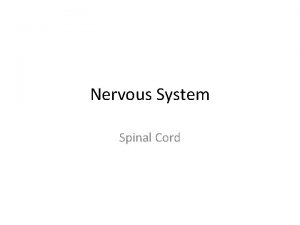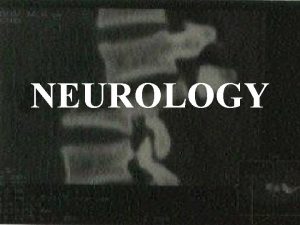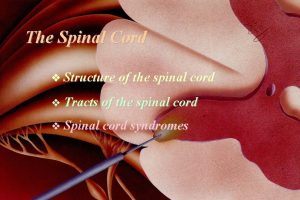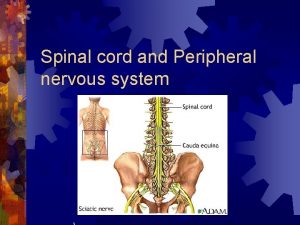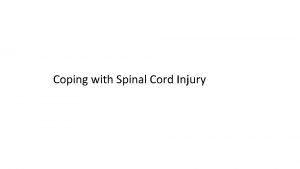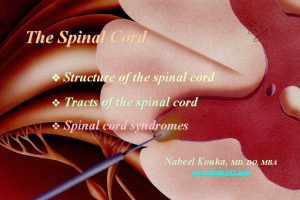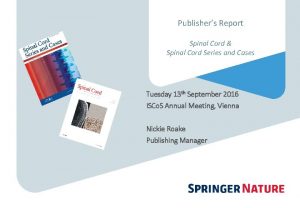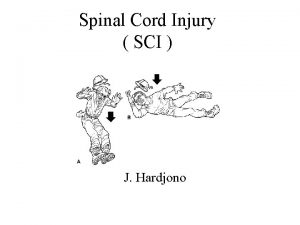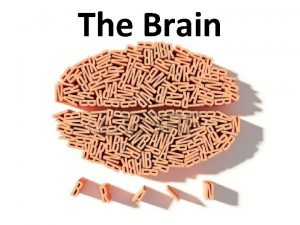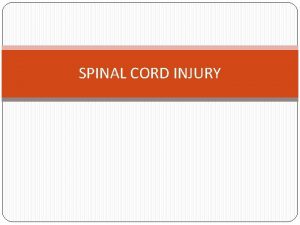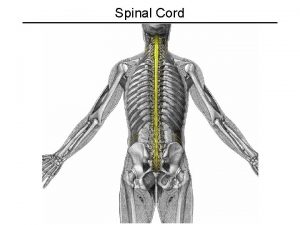Lesions of the spinal cord Spinal cord lamination





























- Slides: 29

Lesions of the spinal cord

Spinal cord lamination

Complete spinal cord transection (Transverse myelopathy) o o o All acsending tracts from below the level of the lesion and all descending tract from above the level of lesion interrupted. Motor , sensory, autonomic functions below the level of lesion disturbed Causes : traumatic spine injuries tumour multiple sclerosis vascular disorders spinal epidural hematoma/abscess auto immune disease herniated intervertebral disc parainfectious/post vaccinal syndrome

o Ø Ø Ø • Ø Ø Ø Sensory disturbances: soft touch, pain, temperature, position, vibration impaired below the level of lesion band like radicular pain/segmental paraesthesia at the level of lesion localised vertebral spine pain- destructive lesions Motor disturbances: paraplegia/quadriplegia acute- flaccid/areflexic-spinal shock latter- hypertonic/hyper reflexic, loss of superficial reflexes, babinski +, flexor/extensor spasm extension of hip , knee occurs in high spinal & incomplete lesion flexion of hip , knee occur in low spinal & complete lesion

Ø • Ø Ø Ø Ø at the level of lesion – paresis, atrophy, fasciculations, and areflexia(LMN signs) in a segmental distribution because of damage to the anterior horn cells and ventral roots Autononomic disturbances: initially atonic, latter spastic bladder, rectal sphincter disturbances orthostatic hypotension trophic skin changes anhydrosis impaired temperature control vasomotor instability sexual disturbances I/L horner syndrome

Hemisection of the spinal cord ( Brown sequard syndrome) o o Loss of pain, temp C/L to the hemisection- interruption of crossed spino thalamic tract I/L loss of proprioception – interruption of ascending fibers of posterior column I/L spastic weakness due to interruption of descending cortico spinal tract Segmental LMN signs and sensory changes at the level of lesion due to damage of the roots and anterior horn cells at the level of lesion

Central spinal cord lesion o o o Spinal cord damage starts centrally and spreds centrifugally Decussating fibers of spinothalamic tract involved initially Thermo anaesthesia, analgesia in a ”vest like” or “suspended” bilateral distribution with preservation soft touch sensation and proprioception--dissociation of sensory loss

o o o Forward extension of disease anterior horn cells inv- segmental neurogenic atrophy, paresis, areflexia Lateral extension I/L horner syndrome kypho scoliosis spastic paralysis Dorsal extension I/L position sense, vibratory loss Extreme venterolateral extension thermo anaesthesia, analgesia with sacral sparing Neuropathic arthropathy Pain

Acute cervical central spinal cord syndrome o o o o Severe hyper extension injuries of neck Pt becomes quadriplegic after trauma, and regains strength in hours even in mnts Urinary retention Patchy sensory loss below the lesion Weakness more in arms, more distal than proximal “man in a barrel syndrome” Considerable recovery Due to damage of central grey matter, lateral cortico spinal tract at cervical enlargement

Postero lateral column disease SACD- B 12 def o Vacuolar myelopathy. AIDS-HTLV 1, tropical spastic paraparesis o Cervical spondylosis -paraesthesia, diffficulty with gait , balance, loss of vibration and proprioception, sensory ataxia, rombergs +, bladder atony, reflexes lost or hypo active – super imposed peripheral neuropathy o

Posterior column disease o o o o Tabes dorsalis- tabetic neuro syphilis, progressive locomotor ataxia Impaired vibration and position sense, and decreased tactile localisation Lability of mechanical sensation threshold, tactile & postural hallucinations, persistence of mechano receptor sensation, disturbances in the knowledge of extremity movement and positions( temporal & spatial disturbances) Sensory ataxia in dark, romberg + Ataxic / stomping/ double tapping gait Positive sink sign In tabes dorsalis- lancinating pain, urinary incontinence, -ve patellar and ankle DTR, hypotonic limb, hyper extensible joints abdominal , laryngeal crises Abadie’s sign , impaired light touch perception in hitzig zone Argyll robertson pupil, optic atrophy, ptosis, ophthalmoplegia

Lhermitte sign or barber chair syndrome due to increased mechano sensitivity Truncal and gait ataxia : also seen in mets causing cord compression impaired conduction in dorsal spino cerebellar tract may be a primary manifestation of epidural spinal cord compression- lower extremity dysmetria and gait ataxia, pt usually have thoracic spine compression due to selective vulnerability of spinocerebellar tract in thoracic spine to compressive ischemia

Anterior horn cell syndrome o o o Aterior horn cell, cranial motor nuclei involved Autosomal recessive spinomuscular atrophy Diffuse weakness and atrophy, fasciculations of trunk and extremities Muscle tone& DTR ↓ Sensation intact

Combined anterior horn cell and pyramidal tract disease o o o Progressive diffuse LMN signs with UMN dysfunction Striated muscles except pelvic floor mucles affected U/L, muscles of hands and foot are involved Sparing rectal and urethral sphincter Bulbar and pseudobulbar inv super imposed

Vascular syndromes of spinal cord Anterior spinal artery syndrome: Territory – anterior funiculi, anterior horn, base of the dorsal horn, peri ependymal area, antero medial aspect of lateral funiculi Lower thoracic sement and conus- vulnerable Abrupt onset of radicular pain, girdle pain Flaccid quadriplegia, paraplegia Bowel bladder dysfunction Thermo anaesthesia analgesia Position vibration light touch preserved Painful burning dysasthesia Watershed boundary zone. T 1 -T 4, L 1, central white matter of anterior funiculi o

Venous spinal cord infarction: Impaired venous drainage, insitu thrombosis Retrograde emboli Chronic venous hypertension- irreversible spinal injury Slowly progressive myelopathy, varying degrees of pain and sensory disturbances in the extremities, bladder bowel disturbances o

Posterior spinal artery syndrome: Uncommon Loss of position , proprioception, vibration Loss of segmental reflexes Pain , temperature – preserved Motor function- preserved Rarely – U/L posterior horn, lateral spinal cord inv o Lacunar infarct: Isolated focal motor/sensory deficits in extremities o Hypoxic myelopathy: Slowly progressive paraparesis/quadriparesis o Hemoynaemic TIA: spinal cord claudication o

Localisation of spinal cord lesion at different levels o Foramen magnum syndrome & lesions of upper cervical cord: Sub occipital pain in C 2 distribution, neck stiffness, electric shock like sensation sub occipital paraesthesia, syringo myelic type of sensory dissociation, finger tip numbness and tingling Spastic tetraparesis, long tract sensory findings, lower cranial nerve palsy “around the clock presentation of UMN type of weakness foramen magnum lesion- down beat nystagmus, papilloedema , cerebelar ataxia causes: tumour, cx spondylosis, basilar invagination in pagets disease , syrinx, C 1 C 2 subluxation, chiari, MS

Pyramidal tract decussates at cervicomedullary jnlesion at this place causes HEMIPLEGIA CRUCIATA, onion skin pattern of facial sensory loss, respiratory insufficiency, bladder dysfunction Compressive lesion of C 1 -C 5 cord segment may compromise the cranial nerve 11 C 3 -C 5 lesion produces diaphragmatic paralysis High cervical cord lesion- respiratory arrest

o Lesions of C 5 -C 6: LMN signs at corresponding segment level. UMN sign below the lesion, LMN paresis of arm associated with spastic para paresis of lower extremities. C 5 level: Diaphragmatic function compromised BJ&BRJ –ve TJ & FFR ++++ Inversion of brachio radialis reflex Sensory loss entire body below neck and anterior shoulder C 6 level: BJ, BRJ, TJ –ve & FFR ++++ Sensory loss samme as that of C 5 lesion sparing the lateral part of arm

Lesion at C 7: Diaphragm fn normal Paresis of flexors and extensors of wrist and fingers BJ, BRJ-Normal, FFR++++ Paradoxical triceps jerk Sensory loss at /below 3 rd 4 th finger o Lesion at C 8 T 1: Weakness of small muscles of hands with spastic paraparesis C 8 inv- TJ &FFR-ve T 1 inv-TJ –Normal, FFR-ve U/L or B/l horner syndrome Sensory loss starts from fifth digit o

Lesion of thoracic segment level: Root pain , paraesthesia mimicking intercostal neuralgia Segmental LMN paralysis Paraplegia and sensory loss below a thoracic level Bladder, bowel sexual dysfunction Lesion above T 5 - orthostatic hypotension, episodic autonomic dysreflexia Lesion at T 10 - +ve Beevors sign Lesion at T 6 - abdominal reflex –ve Lesion at T 10 – upper, middle part +ve Lesion at T 12 - abdominal reflex intact o

Lesion at L 1: All muscles of lower extremities – weak Lower abd musc- Internal oblique, tr abd weak Sensory loss – both lower limbs up to groin, to a level above buttocks Chronic lesion- patellar++++, ankle++++ o Lesion at L 2: Spastic paraparesis Cremasteric reflex↓↓, patellar reflex ↓↓ Ankle jerk ++++ Sensation in upper anterior aspect preserved o

Lesion at L 3: Some preservation of hip flexion, adduction KJ ↓↓, ankle++++ Sensation upper anterior aspect of thigh normal o Lesion at L 4: Better hip flexion, adduction Able to stand stabilising knee KJ↓↓ , ankle++++ Sensation normal in anterior aspect of thigh, superomedial aspect of knee o Lesion at L 5: Normal hip flexion, adduction KJ- normal, ankle++++ pt extends knee against resistance Sensation normal in antr aspect of thigh, medial aspect of legs ankle and sole o

Lesion at S 1: Weakness of triceps surae, flexors of foot, and small muscles of foot Ankle reflex↓↓, KJ-normal Sensory loss- sole, heel, outer aspect of foot and ankle, medial aspect of calf, posterior thigh, outer aspect of saddle area also anaesthetic o S 2 lesion: Triceps surae spared, flexors of toes, small muscles of foot weakness Ankle jerk ↓↓ Sensory loss- upper part of dorsal aspect of calf, dorsolateral aspect of thigh and saddle area o

Conus medullaris lesion Pelvic floor weakness, early sphincter dysfunction Autonomous neurogenic bladder Constipation, impaired ejeculation and errection Symmetric saddle anaesthesia Pain Tethered spinal cord: numbness feet asymmetric muscle atrophy of calf and thigh, UMN signs, bowel bladder dysfunction, foot deformities, cutaneous manifestations of spinal dysraphism

Cauda equina lesion o o o Compression lumbar sacral roots below L 3 vertebra U/L early radicular pain, worse at night Flaccid hypotonic areflexic paralysis producing peripheral paraplegia Asymmetrical sensory loss in saddle area KJ variable, ankle ↓↓ Sphincter dysfunction similar to conus lesion but late

Spont pain sensory deficit Motor loss DTR Bowel, bld trophic Sex fn onset Conus lesion -ve, B/L Saddle, B/L dissociation Symmetric, fasciculations Ankle -ve early +ve impaired Sudden. b/l Cauda lesion +ve, severe, Radicular, U/L saddle. , U/L All forms affected Asymmetric , atro Phy, no fasciculn KJ, ankle -ve late -ve Less impaired Gradual, u/l

signs Radicular pain Vertebral pain Funicular pain Umn Sign Lmn sign Paraesthesi a progr sphincter Trophic intramedullary unusual extramedullary common unusual common Less common +, late +++, diffuse descending +, early Unusual, segmental ascending early common late unusual
 Rubrospinal
Rubrospinal Our old trusty truck cranial nerves
Our old trusty truck cranial nerves Figure 13-1 the spinal cord
Figure 13-1 the spinal cord Spinal cord anatomy
Spinal cord anatomy Latin meaning of phylum and class
Latin meaning of phylum and class Meninges
Meninges Low back rom
Low back rom Spinal cord vibration
Spinal cord vibration Spinal cord
Spinal cord Scottie dog lumbar spine
Scottie dog lumbar spine Spinal shock vs neurogenic shock
Spinal shock vs neurogenic shock Spinal cord injury rehabilitation st. louis
Spinal cord injury rehabilitation st. louis Spinal cord anterior
Spinal cord anterior Spinal cord
Spinal cord Renshaw cell inhibition
Renshaw cell inhibition Diet for spinal cord injury patient
Diet for spinal cord injury patient Slidetodoc
Slidetodoc Nerves branching beyond the spinal cord into the body
Nerves branching beyond the spinal cord into the body Somatic nervous system
Somatic nervous system Spinal cord
Spinal cord Spinal cord
Spinal cord 31 pairs of spinal nerves
31 pairs of spinal nerves Pyramidal tract
Pyramidal tract Spinal cord injury protocol
Spinal cord injury protocol Spinal cord cross section
Spinal cord cross section Nice spinal cord compression
Nice spinal cord compression Spinal cord
Spinal cord Christopher reeve spinal cord injury level
Christopher reeve spinal cord injury level Oligodendrocyte histology
Oligodendrocyte histology Spinal cord organization
Spinal cord organization




